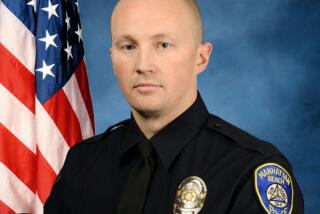Caltrans Sued Over Fatal Crash
- Share via
The family of a man who was killed in a head-on collision with a big rig on the Long Beach Freeway has sued the state, alleging that the median guardrail is inadequate to keep trucks from punching across into oncoming traffic.
Antonio Esquivias, an Inglewood truck driver, was killed in November 2001 when a truck heading in the opposite direction crossed several lanes and plowed through the wood-and-metal guardrail, ramming head-on into Esquivias’ vehicle.
Three months later, another big rig smashed through the barrier a few miles north of the Esquivias accident site on the Long Beach Freeway, killing a Los Angeles Superior Court commissioner and injuring nine others.
State Department of Transportation officials declined to comment on the lawsuit, but they noted that Caltrans is in the process of replacing the wood-and-metal barriers with reinforced concrete barriers on the entire 24.5-mile stretch of the Long Beach Freeway.
Truck accidents are a serious concern on the freeway because it is a preferred route of trucks hauling cargo between the ports of Los Angeles and Long Beach and rail transfer yards near downtown Los Angeles. The freeway carries an average of 200,000 vehicles a day, including 22,600 trucks. It was designed in the 1950s to carry only half that much truck traffic.
In the last five years, accidents involving trucks have killed 19 people on the Long Beach Freeway, according to the California Highway Patrol. The CHP data do not indicate how many of those deaths were caused by trucks that crossed the center divider.
Crash studies have shown that reinforced concrete barriers, often known as Jersey barriers because New Jersey pioneered their use, are more effective at preventing vehicles from crashing through the center divider.
“Concrete with steel right away beats metal and wood,” said Stephanie Faul, a spokeswoman for the AAA Foundation for Traffic Safety.
The Jersey barriers are wider at the bottom and narrower at the top so that a vehicle generally gets diverted back into its own lane. A Jersey barrier can weigh up to 600 pounds per linear foot and can cost two to three times more than the wood-and-metal alternative.
“The metal beams on wood posts are not intended to redirect or contain large trucks,” said Roger Bligh, an engineer with the Texas Transportation Institute who has tested various freeway barriers.
Still, Bligh warned that the Jersey barriers are not always guaranteed to contain a speeding 80,000-pound truck.
“Obviously, it’s going to vary with the impact severity and the weight of the truck,” he said.
State guidelines recommend using concrete barriers on busy freeways that have narrow medians and a history of cross-median accidents.
In 2001, Caltrans launched a $400-million effort to repave the Long Beach Freeway and replace the wood-and-metal median barriers with Jersey barriers. The project won’t be completed until 2007.
The wrongful-death lawsuit, filed Wednesday, charges that Caltrans should have replaced the wood-and-metal barriers years ago, knowing the truck volume on the freeway and the potential for trucks crashing through the divider. The lawsuit does not include an amount for damages, but Miguel Garcia, an attorney for the Esquivias family, said a previous claim filed against Caltrans in the same case asked for $10 million.
The accident occurred Nov. 15, 2001, as Esquivias was heading home from his job as a trucker, driving south in his car on the freeway, just north of Firestone Boulevard.
The driver of a big rig heading north lost control of the truck, swerved across several lanes of traffic, smashed through the barrier and rammed into Esquivias’ car and several other motorists. Esquivias died at the scene.
On Jan. 17, 2002, a similar accident on the Long Beach Freeway near Bandini Boulevard killed Los Angeles Superior Court Commissioner Jeffrey Marckese and injured nine.
More to Read
Sign up for Essential California
The most important California stories and recommendations in your inbox every morning.
You may occasionally receive promotional content from the Los Angeles Times.














